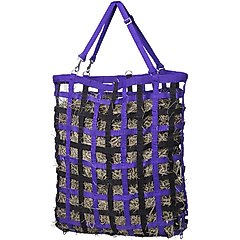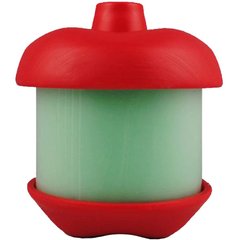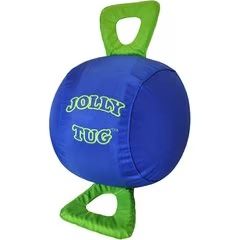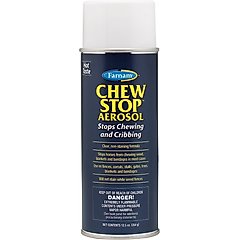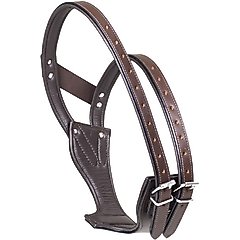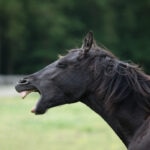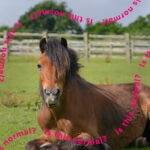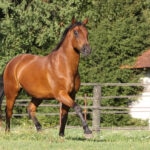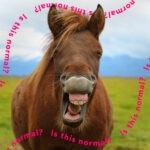Why Is My Horse Crib-Biting? Is Horse Cribbing Normal?
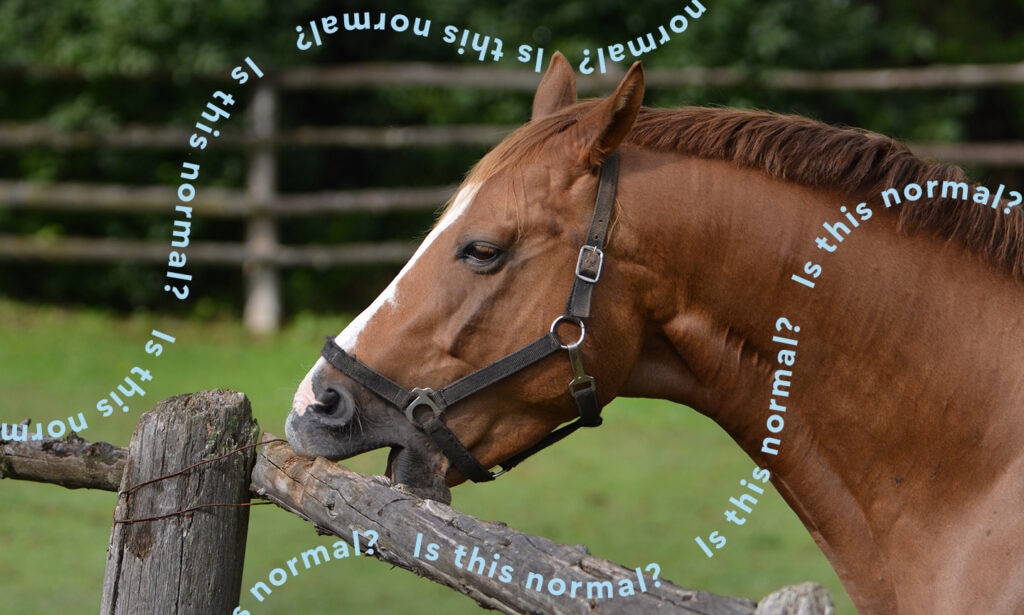
Photo by Chewy
Q: I’m a novice rider considering adopting a retired racehorse who is a “cribber.” He bites down on the edge of a fence or his stall door, then leans back while making a grunting noise, like he’s gulping air. Some of my friends say they would never own a cribber. Is horse cribbing normal behavior or a serious problem?
A: Cribbing, also called “windsucking” or “crib-biting” in horses, is common, but it’s not normal and can be harmful to the horse. The good news is that lifestyle changes and behavior management may help your horse feel better and crib less.
To learn more about cribbing in horses, we spoke to practicing equine veterinarian Richard L. Stevens, DVM, of Conejo Valley Equine in Thousand Oaks, California; Grey Parks, MS, equine nutritionist at ProTrition in La Vergne, Tennessee; and researcher and animal behavior textbook author Katherine Houpt, VMD, PhD, professor emeritus in behavior medicine at Cornell University in Ithaca, New York, who led several studies of cribbing in horses.
What Is Horse Cribbing?
Dr. Houpt says it’s important to make sure you’re actually observing cribbing before deciding how to address it.
“Cribbing is when the horse grasps something with its teeth, arches its neck, and aspirates air,” Dr. Houpt says. “Wood chewing is not cribbing. Wood chewing is when your wooden fences gradually disappear.”
Cribbing in horses is a stereotypy or stereotyped behavior. However, this isn’t the same thing as a stereotype in the context of human social groups. In behavioral science, a “stereotypy” is a behavior that is repeated over and over, with no apparent adaptive benefit to the person or animal repeating it. Common stereotypies in horses are pacing, weaving, and, of course, cribbing.
Cribbing affects 2–10% of domestic horses and is rarely seen in wild horses, suggesting it’s linked to how we manage them.
Why Do Horses Crib?
Scientists and veterinarians have identified several factors that may increase or reduce the risk of cribbing in horses. Dr. Stevens and Dr. Houpt say key reasons horses crib include the following.
1. They’re Weaning
Cribbing often starts at weaning. Gradual weaning and forage-based diets reduce risk.
According to a 2010 study, foals fed concentrates (e.g., sweet feed and other grains) after weaning were four times as likely to crib, compared to foals eating only forage.
2. They Inherited the Behavior
Cribbing is at least partially heritable. While researchers do not currently believe there is a specific gene that controls cribbing, it can run in families.
Cribbing is more common in Thoroughbreds and warmbloods than in other breeds. Dr. Houpt recommends not breeding cribbers due to the risk of passing along the vice.
3. They Feel Confined
The more hours a horse spends in a stall or small paddock per day, the more likely they are to crib.
Of course, this isn’t an absolute cause-and-effect relationship. Many stalled horses never crib, although they may exhibit other problematic behaviors.
However, increased access to turnout is associated with improved welfare overall in horses.
4. Their Diet Is High in Sweetened Grains
What you feed your horse can impact their chances of cribbing. Forage-based diets may reduce cribbing risk. Concentrates and sweetened grains increase it.
According to a 2016 study, horses that were offered a device dispensing small amounts of highly palatable feed on demand cribbed less, as did horses offered unlimited concentrates in another study. In a third, 2011 study, a foraging toy that horses could lick, rather than bite, reduced cribbing.
However, don’t offer your horse unlimited grain in an attempt to reduce cribbing. Excess concentrated feed can promote obesity, ulcers, and metabolic disorders.
5. They Have a Neurological Issue
Alongside several other brain differences, cribbers have twice as many endorphin-binding sites in their brains as non-cribbers. This may mean they experience pleasure and rewards more intensely than other horses.
That, in turn, could explain why one study found cribbers are more prone to habitual responding during training and take longer to stop performing a trained behavior when it’s no longer rewarded.
6. They Feel Isolated
Horses are herd animals and show a more positive emotional state when allowed to interact with others. So, horses denied social contact with other equines may be more prone to cribbing.
Studies strongly suggest cribbing is not socially learned, so there’s little risk that adding a crib-biting horse to a herd will “teach the other horses to crib.”
“It’s a very low percentage,” Dr. Houpt says. “So, banning horses from a boarding situation out of fear they will teach others to crib is not justified.”
Is Horse Cribbing a Problem?
Yes, horse cribbing is a problem, though the severity of the habit varies widely.
Cribbing can cause colic, dental damage, and weight loss. Stress may also link cribbing and ulcers.
How To Stop a Horse from Cribbing
You may not be able to cure it—but you can definitely help. Cribbing is likely to be a lifelong tendency once the habit is established in an adult horse. Even if mostly halted, cribbing may return in times of stress.
So, humans caring for cribbers must decide whether or not to attempt to physically block the horse from cribbing by using cribbing collars and/or other barriers, like electric fencing.
Here are some ways to help your cribbing horse. Always speak with your equine veterinarian before implementing a behavior modification program.
Provide More Turnout (in a Group, if Possible)
The trifecta of “freedom, forage, friends” is key to maximizing equine welfare.
Full-time turnout on grass with a compatible herd is likely the ideal for cribbing management, but may be impossible in your location or unhealthy for horses prone to obesity.
Fortunately, research suggests that any increase in turnout can increase your horse’s well-being.
Feed More Forage and Less Concentrates
Maximize the number of hours per day your horse spends eating forage. If your horse needs more than hay to maintain weight, try Dr. Houpt’s regimen of unlimited hay plus plain oats.
Hay nets on their own don’t seem to make an impact on the frequency of cribbing, but slow feeders (like the Tough1 Slow Feed Web Hay Horse Feeder) in combination with a change to a more heavily forage-based diet can improve equine welfare overall. Better welfare may reduce stress and, in turn, decrease cribbing.
Recommended Product
Evaluate and Reduce Environmental Stressors
Dr. Stevens’ approach to cribbing begins with stress reduction and creating a social environment. For example, he says sometimes box stalls can be very stressful to some horses.
“Some horses, especially geldings, won’t sleep without a herd around them to signal them that they can safely lie down to sleep,” he adds.
Work with your veterinarian, and potentially a certified horse trainer or behaviorist, to identify key sources of stress in your horse’s life and make changes accordingly.
Offer Foraging Toys When Confinement Is Necessary
Foraging toys aren’t a cure for cribbing, but they do seem to reduce it somewhat when horses must be stalled.
Focus on horse toys that encourage them to lick (like the Horsemen’s Pride Stall Snack Holder) or roll the toy, rather than biting it.
Recommended Product
Boost Enrichment
If your horse cribs even when turned out, consider a track system and add more foraging opportunities and enrichment activities, such as snuffle mats and social toys (like the Horsemen’s Pride Jolly Tug Horse Toy), to the paddock or pasture.
Recommended Product
Reduce Opportunities To Crib
Mild cribbers may stop cribbing entirely if their environment is managed so that they never encounter an appealing fencepost or hitching rail. For instance, some barns run a strand of electrified “hot wire” above all fences that horses could use to crib.
Dr. Stevens says cribbers may show other vices when prevented from cribbing. Some begin windsucking (like cribbing, but without a surface to bite) or even crib on the ground, causing them to swallow dirt.
Speak with your equine veterinarian before making any drastic lifestyle changes to ensure you have a plan in place for potential side effects or new issues.
Treat Frequently Used Surfaces With Cribbing Repellents
Various bitter-tasting stains and anti-cribbing sprays, like the Farnam Chew Stop Aerosol Horse Spray, are available for painting wooden surfaces used for cribbing.
Recommended Product
And while some horses like bitter-tasting sprays, this may not work for all cribbers—but it’s worth a try.
Apply a Cribbing Collar
“If you have a cribber and you’ve had to call the vet more than once for a gas colic, put a cribbing collar [like the Camelot Padded Wonder Horse Crib Collar] on the horse,” Dr. Houpt says.
Recommended Product
Cribbing collars physically prevent the horse’s throat from expanding to crib. Some severely affected horses can crib even while wearing a cribbing collar. Typically, cribbing will return as soon as you remove the collar.
Consult your equine veterinarian before using a cribbing collar to ensure your horse is a suitable candidate.
Consider Medical Options When Stall Rest Is Needed
Your vet may be able to prescribe calming medication to help alleviate cribbing in horses in the short term, but this usually doesn’t provide long-term relief. This is only a suitable option for horses on temporary stall rest.
Speak with your veterinarian about medical options.
FAQs About Horse Cribbing
Should I use a cribbing collar on my horse?
Possibly. Cribbing collars help horses who crib and have a history of colic. Consult with your equine veterinarian to determine if it’s a suitable option.
Does cribbing mean my horse is bored?
It could. Boredom can be stressful, and stress contributes to cribbing. However, cribbing usually starts at weaning and persists even in low-stress environments.
Can cribbing lead to health problems in horses?
Yes. It can increase the risk of colic, damage teeth, cause weight loss, and affect the neck muscles.
Is cribbing more common in certain breeds?
Yes, cribbing is more common in certain horse breeds, such as Thoroughbreds and warmbloods.
Can cribbing be cured?
Once established, cribbing is often a lifelong condition, but it can be managed to reduce its impact on health and property.
